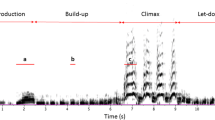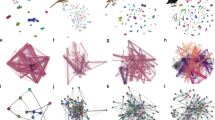Abstract
A scheme for describing how gelada monkeys (Theropithecus gelada) use rhythm and melody in their vocal exchanges with each other is presented. It is argued that four different levels of description—phonological, whole sound, rhythmical, and syntactical—are necessary for an adequate account of geladas' use of rhythm and melody. Many examples of gelada rhythm and melody are demonstrated from sonagraphs. It is argued that geladas use rhythm and melody in their vocal exchanges in ways that are similar to how humans use rhythm and melody in speech and singing. Geladas make use of rhythm and melody in human-like ways todesignate utterance acts, todistinguish kinds of utterance acts from each other, toparse utterances into smaller units, and toresolve emotional arousal conflicts through the structuring of rhythm and melody.
Similar content being viewed by others
References
Blacking, J., 1973.How Musical Is Man? Univ. of Washington, Seattle.
Cheney, D. L. &R. M. Seyfarth, 1982. Vervet monkey vocalizations.Anim. Behav., 30: 739–751.
Chomsky, N. &M. Halle, 1968.The Sound Pattern of English. Harper & Row, New York.
Dunbar, R. &P. Dunbar, 1975.Social Dynamics of Gelada Baboons. S. Karger, Basel.
Green, S., 1975. Variation of vocal pattern with social situation in the Japanese monkey. In:Primate Behavior, Vol. 4,L. A. Rosenblum (ed.), Academic Press, New York, pp. 1–103.
Kawai, M., 1979.Auditory Communication and Social Relations. Contributions to Primatology, Vol. 13. S. Karger, Basel.
Kummer, H., 1974. Rules of dyad and group formation among captive gelada baboons (Theropithecus gelada). In:Proc. Symp. 5th Congr. Int. Primatol. Soc.,S. Kondo,M. Kawai,A. Ehara, &S. Kawamura (eds.), Japan Science Press, Tokyo, pp. 139–159.
Ladefoged, P., 1971.Preliminaries to Linguistic Phonetics. Univ. of Chicago Press, Chicago.
Langer, S. K., 1942.Philosophy in a New Key. Harvard Univ., Cambridge.
Lieberman, P., 1984.Biology and Evolution of Language. Harvard Univ., Cambridge.
Malcolm, N., 1977.Memory and Mind. Cornell Univ., Ithaca.
Marler, P., 1977. The signaling behavior of apes. In:How Animals Communicate.T. Sebeok (ed.), Indiana Univ. Press, Bloomington, pp. 955–1035.
Patterson, F., 1981.Education of Koko. Holt, New York.
Richman, B., 1976. Some vocal distinctive features used by gelada monkeys.J. Acoust. Soc. Amer., 60: 687–695.
—, 1978. Synchronization of voices by gelada monkeys.Primates, 19: 569–581.
Seyfarth, R. M. &D. L. Cheney, 1982. How monkeys see the world. In:Primate Communication,C. T. Snowdon,C. H. Brown, &M. R. Peterson (eds.), Cambridge Univ. Press, New York, pp. 239–252.
Terrace, H. S., 1979.Nim. Knopf, New York.
—, 1983. Apes who “talk”: language or projection of language by their teachers? In:Language in Primates,J. de Luce &H. T. Wilder (eds.), Springer-Verlag, New York, pp. 19–42.
Author information
Authors and Affiliations
About this article
Cite this article
Richman, B. Rhythm and melody in gelada vocal exchanges. Primates 28, 199–223 (1987). https://doi.org/10.1007/BF02382570
Received:
Accepted:
Issue Date:
DOI: https://doi.org/10.1007/BF02382570




